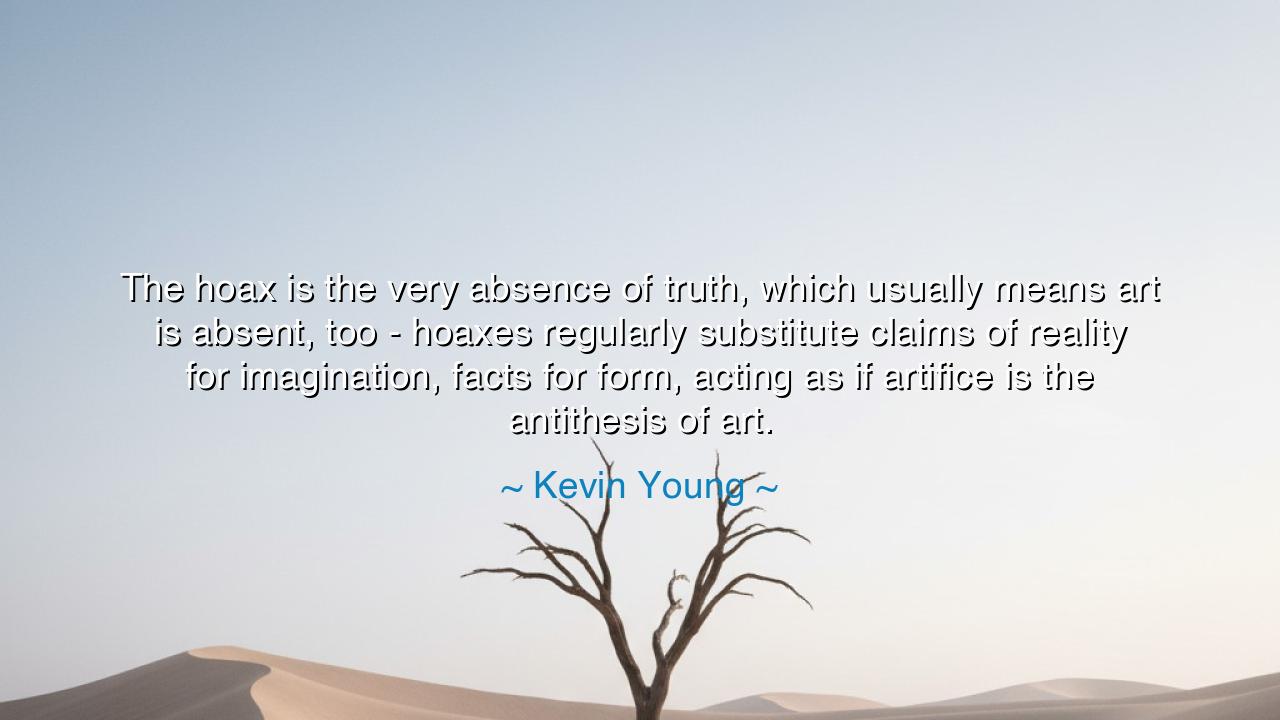
The hoax is the very absence of truth, which usually means art is
The hoax is the very absence of truth, which usually means art is absent, too - hoaxes regularly substitute claims of reality for imagination, facts for form, acting as if artifice is the antithesis of art.






“The hoax is the very absence of truth, which usually means art is absent, too — hoaxes regularly substitute claims of reality for imagination, facts for form, acting as if artifice is the antithesis of art.” Thus spoke Kevin Young, the poet and scholar, whose meditations on deception and authenticity pierce like arrows through the fog of illusion. In this profound reflection, he draws a sacred line between art and falsehood, between the creative shaping of truth and the hollow imitation of it. For the hoax, he reminds us, is not art — it is the shadow of art, a hollow echo that mimics creation while forsaking its spirit.
The hoax, in Young’s understanding, pretends to truth while lacking its essence. It does not imagine — it claims. It does not create — it copies. The hoaxer does not seek to illuminate reality, but to exploit belief. And thus, in this absence of sincerity, art disappears. For art, even in its artifice, serves truth — not the factual truth of newspapers and ledgers, but the deeper truth of human experience. The imagination, when it shapes a story or a painting or a song, does not lie; it reveals the invisible through symbol and beauty. But the hoax, while pretending to be real, denies the creative spirit. It reduces form to trickery and replaces meaning with manipulation.
This is why Kevin Young, in his studies of deception, speaks with both sorrow and reverence. He knows that artifice — the deliberate shaping of illusion — is not the enemy of art, but its very essence. The artist, like the ancient dramatist, crafts masks not to deceive, but to express. The mask, in sacred theatre, reveals truth through performance; the hoax, however, conceals it beneath pretense. One opens the soul; the other shuts it. Thus, the difference between art and hoax lies not in appearance, but in intention. Art seeks communion; the hoax seeks control.
Consider, for instance, the tale of Orson Welles and his 1938 radio broadcast of The War of the Worlds. When listeners mistook the dramatization for reality, panic swept across cities. Yet Welles had not set out to deceive; he had set out to imagine, to perform, to use artifice as a mirror for the power of belief itself. His work, though mistaken for truth, remained art — because it sought understanding, not exploitation. In contrast, when history has met true hoaxes — forged letters, false memoirs, fake artifacts — they crumble under the weight of their emptiness. They leave behind no beauty, no resonance, no lasting insight. For they have no imagination, only imitation.
The ancients understood this difference well. In the myths of old, artifice was divine — a sacred craft bestowed by the gods. The poet’s task was not to recount facts, but to unveil the hidden order of existence through imagination. Homer’s epics were not histories, yet they spoke of truths more enduring than time itself. Art could use illusion to reveal wisdom; the hoax could only use illusion to conceal it. And so, even in their fictions, the ancients were truthful — for they knew that the heart’s truth matters more than the mind’s record.
Kevin Young’s warning is not merely about deception in art, but about deception in life. We live in an age where hoaxes abound — where falsehood dresses itself in the garments of truth, and spectacle replaces sincerity. In such a world, we must guard the imagination, for it alone can restore balance. To imagine honestly is to create meaning; to fabricate falsely is to destroy it. The hoax thrives where curiosity dies, where people hunger for certainty instead of wonder. The artist’s duty, then, is not to claim reality, but to awaken it — to remind the world that truth lives not in data or deceit, but in the living pulse of imagination.
The lesson, then, is clear: honor truth through artifice, but never artifice without truth. Let your imagination serve honesty, not ego. When you create, ask yourself: does this reveal or does it obscure? Does it bring light or only illusion? For in every craft — writing, teaching, building, loving — the line between art and hoax is drawn in the heart. The one who creates from sincerity, even when inventing, tells truth; the one who pretends, even when factual, lies.
So remember, children of thought and spirit: the hoax is not dangerous because it is false, but because it is empty. It offers imitation without insight, spectacle without soul. Let your art, your words, your very life, be filled instead with the radiance of imagination — that sacred power which transforms illusion into revelation. For as Kevin Young teaches, art is not the absence of artifice, but its consecration; and when truth and imagination join hands, even the smallest act of creation becomes divine.






AAdministratorAdministrator
Welcome, honored guests. Please leave a comment, we will respond soon